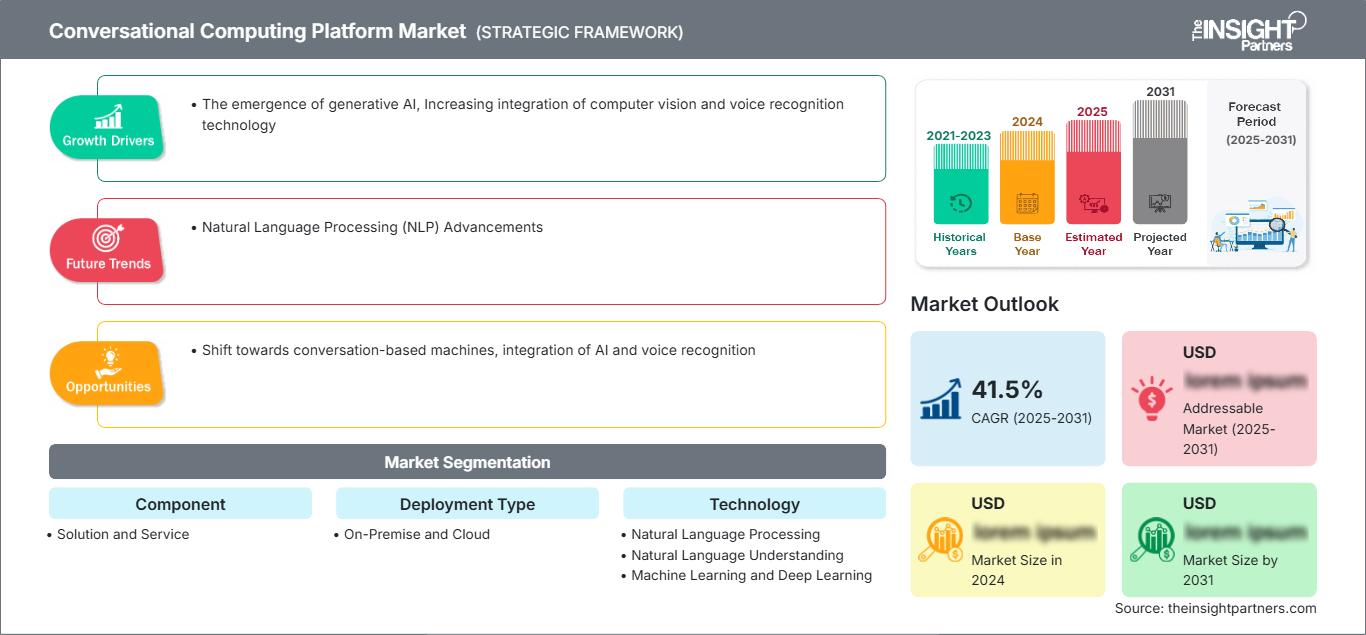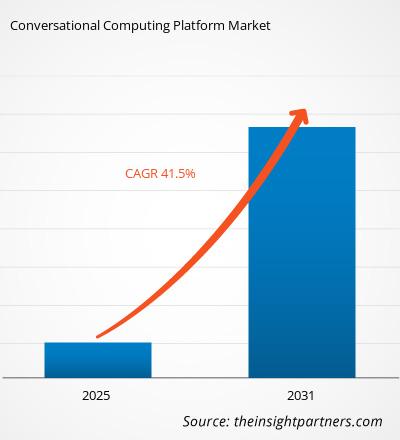Der Markt für Conversational-Computing-Plattformen wird zwischen 2023 und 2031 voraussichtlich eine durchschnittliche jährliche Wachstumsrate (CAGR) von 41,5 % verzeichnen. Der Trend zu konversationsbasierten Maschinen und die Integration von KI und Spracherkennung bleiben voraussichtlich die wichtigsten Trends auf dem Markt.
Marktanalyse für Conversational-Computing-Plattformen
- Die Conversational-Computing-Plattform ist eine der am schnellsten angenommenen Kategorien branchenübergreifend. Unternehmen nutzen Konversations-KI-Technologien, um die Kundeninteraktion zu verbessern, den Kundensupport zu automatisieren und Geschäftsprozesse zu vereinfachen.
- Der Einsatz von Conversational-Computing-Plattformen im Bankwesen, Gesundheitswesen, E-Commerce und der Reisebranche gewinnt zunehmend an Akzeptanz, um eine stärkere Kundenbindung und betriebliche Effizienz zu erzielen.
Marktüberblick über Conversational-Computing-Plattformen
- Der Markt für Conversational-Computing-Plattformen steckt voller Potenzial und bietet enorme Möglichkeiten. Die zunehmende Nutzung von Chatbots in Messaging-Anwendungen und sprachbasierten Assistenten treibt das Wachstum dieser Branche sicherlich voran.
- Heutzutage werden Conversational-Computing-Plattformen für automatisierte Konversationstechniken eingesetzt, die eine einfache Konversation zwischen Kunde und KI-System ermöglichen. Der Markt wächst und breitet sich über verschiedene Regionen aus.
- Die zunehmende Nutzung von Cloud-Bereitstellungen und Innovationen im Bereich NLP können ebenfalls als Auslöser für die Expansion angesehen werden. Diese Trends spiegeln den Wandel im Markt für Conversational-Computing-Plattformen wider, der hauptsächlich durch die Entwicklung von KI-Technologien und die Kundennachfrage nach personalisierteren Erlebnissen vorangetrieben wird.
Passen Sie diesen Bericht Ihren Anforderungen an
Sie erhalten kostenlos Anpassungen an jedem Bericht, einschließlich Teilen dieses Berichts oder einer Analyse auf Länderebene, eines Excel-Datenpakets sowie tolle Angebote und Rabatte für Start-ups und Universitäten.
Markt für Conversational Computing-Plattformen: Strategische Einblicke

- Holen Sie sich die wichtigsten Markttrends aus diesem Bericht.Dieses KOSTENLOSE Beispiel umfasst Datenanalysen, die von Markttrends bis hin zu Schätzungen und Prognosen reichen.
Treiber und Chancen für den Markt für Conversational Computing-Plattformen: Das Aufkommen generativer KI begünstigt den Markt
Sie erhalten kostenlos Anpassungen an jedem Bericht, einschließlich Teilen dieses Berichts oder einer Analyse auf Länderebene, eines Excel-Datenpakets sowie tolle Angebote und Rabatte für Start-ups und Universitäten.
Markt für Conversational Computing-Plattformen: Strategische Einblicke

- Holen Sie sich die wichtigsten Markttrends aus diesem Bericht.Dieses KOSTENLOSE Beispiel umfasst Datenanalysen, die von Markttrends bis hin zu Schätzungen und Prognosen reichen.
- Ein weiterer wichtiger Treiber für den Markt für Conversational Computing-Plattformen ist das Aufkommen generativer KI, die fortschrittlichere und natürlichere Interaktionen zwischen Menschen und KI-Systemen ermöglicht.
- Generative KI-Modelle, die auf Deep-Learning-Algorithmen und neuronalen Netzwerken basieren, haben ihre Fähigkeiten, menschenähnliche Reaktionen zu verstehen und zu generieren, um ein Vielfaches verbessert.
- Diese Entwicklung generativer KI macht die Interaktion für Benutzer noch dialogorientierter, interaktiver und ansprechender. Daher werden Conversational Computing-Plattformen branchenübergreifend zunehmend von Unternehmen eingesetzt, die generative KI optimal für die Bereitstellung nahtloser Konversationsinteraktionen mit Kunden nutzen möchten.
Fortschritte in der Verarbeitung natürlicher Sprache (NLP)
- Fortschritte in der NLP eröffnen enorme Chancen für den Markt für Conversational Computing-Plattformen. NLP hilft Computern dabei, natürlich klingende und realistische Texte oder Sprache zu generieren, wodurch die Qualität der Gespräche zwischen Mensch und KI-System verbessert wird.
- Diese Fortschritte treiben die Denkmaschine hinter generativen KI-Systemen an und ermöglichen somit die Entstehung komplexerer und menschenähnlicherer Interaktionen.
- Es verändert die Konversations-KI in den Bereichen Sprachverständnis, Spracherkennung, Stimmungsanalyse und Inhaltsgenerierung. Je fortschrittlicher NLP wird, desto persönlicher und menschlicher werden die Dialoge mit dem KI-Assistenten, was neue Geschäftsmöglichkeiten in der Kundenbindung und der Optimierung von Abläufen eröffnet.
Segmentierungsanalyse des Marktberichts für Conversational Computing-Plattformen
Schlüsselsegmente, die zur Ableitung der Marktanalyse für Conversational Computing-Plattformen beigetragen haben, sind Komponente, Bereitstellungstyp, Technologie, Anwendung und Branche.
- Basierend auf Komponenten ist der Markt für Conversational Computing-Plattformen in Lösungen und Dienste unterteilt.
- Basierend auf dem Bereitstellungstyp ist der Markt für Conversational Computing-Plattformen in On-Premise und Cloud unterteilt.
- Basierend auf der Technologie ist der Markt für Conversational Computing-Plattformen in natürliche Sprachverarbeitung, natürliches Sprachverständnis, maschinelles Lernen, Deep Learning und automatische Spracherkennung unterteilt.
- Basierend auf der Anwendung ist der Markt für Conversational Computing-Plattformen in persönliche Unterstützung, Branding und Werbung, Datenschutz und Compliance, Kundenbindung und -bindung, Kundensupport und andere unterteilt.
- Basierend auf der Branche ist der Markt für Conversational Computing-Plattformen unterteilt in Einzelhandel und E-Commerce, BFSI, Telekommunikation, Unterhaltung und Medien, Reisen und Gastgewerbe und andere
Komponente (Lösung und Service), Bereitstellungstyp (vor Ort und in der Cloud), Technologie (Verarbeitung natürlicher Sprache, Verständnis natürlicher Sprache, maschinelles Lernen und Deep Learning sowie automatische Spracherkennung), Anwendung (persönliche Unterstützung, Branding und Werbung, Datenschutz und -konformität, Kundenbindung und -bindung, Kundensupport und andere), Vertikal (Einzelhandel und E-Commerce, BFSI, Telekommunikation, Unterhaltung und Medien, Reisen und Gastgewerbe und andere)
Marktanteilsanalyse für Conversational Computing-Plattformen nach Geografie
- Der Marktbericht für Conversational Computing-Plattformen umfasst eine detaillierte Analyse von fünf großen geografischen Regionen, einschließlich der aktuellen und historischen Marktgröße und Prognosen für 2021 bis 2031, und deckt Nordamerika, Europa, den asiatisch-pazifischen Raum (APAC), den Nahen Osten und Afrika (MEA) sowie Süd- und Südamerika ab. Mittelamerika.
- Jede Region ist weiter in entsprechende Länder unterteilt. Dieser Bericht bietet Analysen und Prognosen für mehr als 18 Länder und deckt die Marktdynamik von Conversational Computing Platforms ab, wie z. B. Treiber, Trends und Chancen, die die Märkte auf regionaler Ebene beeinflussen.
- Darüber hinaus umfasst der Bericht eine PEST-Analyse, die die Untersuchung der wichtigsten Faktoren umfasst, die den Markt für Conversational Computing Platforms in diesen Regionen beeinflussen.
Markt für Conversational Computing-Plattformen
Die Analysten von The Insight Partners haben die regionalen Trends und Faktoren, die den Markt für Conversational Computing-Plattformen im Prognosezeitraum beeinflussen, ausführlich erläutert. In diesem Abschnitt werden auch die Marktsegmente und die geografische Lage in Nordamerika, Europa, im asiatisch-pazifischen Raum, im Nahen Osten und Afrika sowie in Süd- und Mittelamerika erörtert.Umfang des Marktberichts zur Conversational Computing-Plattform
| Berichtsattribut | Einzelheiten |
|---|---|
| Marktgröße in 2024 | US$ XX million |
| Marktgröße nach 2031 | US$ XX Million |
| Globale CAGR (2025 - 2031) | 41.5% |
| Historische Daten | 2021-2023 |
| Prognosezeitraum | 2025-2031 |
| Abgedeckte Segmente |
By Komponente
|
| Abgedeckte Regionen und Länder | Nordamerika
|
| Marktführer und wichtige Unternehmensprofile |
|
Dichte der Marktteilnehmer für Conversational Computing-Plattformen: Auswirkungen auf die Geschäftsdynamik verstehen
Der Markt für Conversational Computing-Plattformen wächst rasant. Dies wird durch die steigende Endnutzernachfrage aufgrund veränderter Verbraucherpräferenzen, technologischer Fortschritte und eines stärkeren Bewusstseins für die Produktvorteile vorangetrieben. Mit der steigenden Nachfrage erweitern Unternehmen ihr Angebot, entwickeln Innovationen, um den Bedürfnissen der Verbraucher gerecht zu werden, und nutzen neue Trends, was das Marktwachstum weiter ankurbelt.

- Holen Sie sich die Markt für Conversational Computing-Plattformen Übersicht der wichtigsten Akteure
Der Markt für Conversational Computing-Plattformen wird durch die Erhebung qualitativer und quantitativer Daten aus Primär- und Sekundärforschung bewertet, die wichtige Unternehmenspublikationen, Verbandsdaten und Datenbanken umfasst. Einige der Entwicklungen auf dem Markt für Conversational Computing-Plattformen sind nachfolgend aufgeführt:
- Conversica, Inc., der führende Anbieter von Conversational-Automation-Lösungen für Umsatzteams in Unternehmen, hat heute seine neue Lösung für Marketing-Automatisierungsplattformen (MAPs) angekündigt, die KI-gestützte, menschenähnliche Echtzeit-Konversationen direkt in wichtige, pipelinegenerierende Marketingaktivitäten einbettet. (Quelle: Conversica, Inc., Pressemitteilung, März 2024)
Bericht zum Markt für Conversational Computing-Plattformen: Abdeckung und Ergebnisse
Der „Markt für Conversational Computing-Plattformen: Größe und Prognose (2021–2031)“ Der Bericht bietet eine detaillierte Analyse des Marktes und deckt die folgenden Bereiche ab:
- Marktgröße und Prognose für Conversational-Computing-Plattformen auf globaler, regionaler und Länderebene für alle abgedeckten wichtigen Marktsegmente
- Markttrends und Marktdynamiken für Conversational-Computing-Plattformen wie Treiber, Einschränkungen und wichtige Chancen
- Detaillierte PEST/Porters Five Forces- und SWOT-Analyse
- Marktanalyse für Conversational-Computing-Plattformen mit wichtigen Markttrends, globalen und regionalen Rahmenbedingungen, wichtigen Akteuren, Vorschriften und aktuellen Marktentwicklungen
- Branchenlandschaft und Wettbewerbsanalyse mit Marktkonzentration, Heatmap-Analyse, prominenten Akteuren und aktuellen Entwicklungen für den Markt für Conversational-Computing-Plattformen
- Detaillierte Unternehmensprofile
- Historische Analyse (2 Jahre), Basisjahr, Prognose (7 Jahre) mit CAGR
- PEST- und SWOT-Analyse
- Marktgröße Wert/Volumen – Global, Regional, Land
- Branchen- und Wettbewerbslandschaft
- Excel-Datensatz
Aktuelle Berichte
Erfahrungsberichte
Grund zum Kauf
- Fundierte Entscheidungsfindung
- Marktdynamik verstehen
- Wettbewerbsanalyse
- Kundeneinblicke
- Marktprognosen
- Risikominimierung
- Strategische Planung
- Investitionsbegründung
- Identifizierung neuer Märkte
- Verbesserung von Marketingstrategien
- Steigerung der Betriebseffizienz
- Anpassung an regulatorische Trends




















 Kostenlose Probe anfordern für - Markt für Conversational Computing-Plattformen
Kostenlose Probe anfordern für - Markt für Conversational Computing-Plattformen